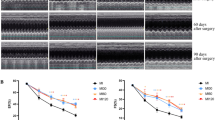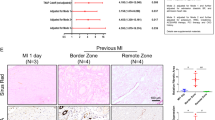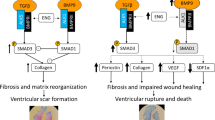Abstract
Osteopontin (OPN) plays an important role in left ventricular (LV) remodeling after myocardial infarction (MI) by promoting collagen synthesis and accumulation. This study tested the hypothesis that MMP inhibition modulates post-MI LV remodeling in mice lacking OPN. Wild-type (WT) and OPN knockout (KO) mice were treated daily with MMP inhibitor (PD166793, 30 mg/kg/day) starting 3 days post-MI. LV functional and structural remodeling was measured 14 days post-MI. Infarct size was similar in WT and KO groups with or without MMP inhibition. M-mode echocardiography showed greater increase in LV end-diastolic (LVEDD) and end-systolic diameters (LVESD) and decrease in percent fractional shortening (%FS) and ejection fraction in KO-MI versus WT-MI. MMP inhibition decreased LVEDD and LVESD, and increased %FS in both groups. Interestingly, the effect was more pronounced in KO-MI group versus WT-MI (P < 0.01). MMP inhibition significantly decreased post-MI LV dilation in KO-MI group as measured by Langendorff-perfusion analysis. MMP inhibition improved LV developed pressures in both MI groups. However, the improvement was significantly higher in KO-MI group versus WT-MI (P < 0.05). MMP inhibition increased heart weight-to-body weight ratio, myocyte cross-sectional area, fibrosis and septal wall thickness only in KO-MI. Percent apoptotic myocytes in the non-infarct area was not different between the treatment groups. Expression and activity of MMP-2 and MMP-9 in the non-infarct area was higher in KO-MI group 3 days post-MI. MMP inhibition reduced MMP-2 activity in KO-MI with no effect on the expression of TIMP-2 and TIMP-4 14 days post-MI. Thus, activation of MMPs contributes to reduced fibrosis and LV dysfunction in mice lacking OPN.






Similar content being viewed by others
References
Denhardt DT, Noda M, O’Regan AW, Pavlin D, Berman JS (2001) Osteopontin as a means to cope with environmental insults: regulation of inflammation, tissue remodeling, and cell survival. J Clin Invest 107:1055–1061. doi:10.1172/JCI12980
Trueblood NA, Xie Z, Communal C, Sam F, Ngoy S, Liaw L, Jenkins AW, Wang J, Sawyer DB, Bing OH, Apstein CS, Colucci WS, Singh K (2001) Exaggerated left ventricular dilation and reduced collagen deposition after myocardial infarction in mice lacking osteopontin. Circ Res 88:1080–1087. doi:10.1161/hh1001.090842
Xie Z, Singh M, Singh K (2004) Osteopontin modulates myocardial hypertrophy in response to chronic pressure overload in mice. Hypertension 44:826–831. doi:10.1161/01.HYP.0000148458.03202.48
Ashizawa N, Graf K, Do YS, Nunohiro T, Giachelli CM, Meehan WP, Tuan TL, Hsueh WA (1996) Osteopontin is produced by rat cardiac fibroblasts and mediates A(II)-induced DNA synthesis and collagen gel contraction. J Clin Invest 98:2218–2227. doi:10.1172/JCI119031
Singh K, Sirokman G, Communal C, Robinson KG, Conrad CH, Brooks WW, Bing OH, Colucci WS (1999) Myocardial osteopontin expression coincides with the development of heart failure. Hypertension 33:663–670
Ahmed SH, Clark LL, Pennington WR, Webb CS, Bonnema DD, Leonardi AH, McClure CD, Spinale FG, Zile MR (2006) Matrix metalloproteinases/tissue inhibitors of metalloproteinases: relationship between changes in proteolytic determinants of matrix composition and structural, functional, and clinical manifestations of hypertensive heart disease. Circulation 113:2089–2096. doi:10.1161/CIRCULATIONAHA.105.573865
Chapman RE, Spinale FG (2004) Extracellular protease activation and unraveling of the myocardial interstitium: critical steps toward clinical applications. Am J Physiol Heart Circ Physiol 286:H1–H10. doi:10.1152/ajpheart.00609.2003
Mori S, Gibson G, McTiernan CF (2006) Differential expression of MMPs and TIMPs in moderate and severe heart failure in a transgenic model. J Card Fail 12:314–325. doi:10.1016/j.cardfail.2006.01.009
Spinale FG (2002) Matrix metalloproteinases: regulation and dysregulation in the failing heart. Circ Res 90:520–530. doi:10.1161/01.RES.0000013290.12884.A3
Aimes RT, Quigley JP (1995) Matrix metalloproteinase-2 is an interstitial collagenase. Inhibitor-free enzyme catalyzes the cleavage of collagen fibrils and soluble native type I collagen generating the specific 3/4 and 1/4-length fragments. J Biol Chem 270:5872–5876. doi:10.1074/jbc.270.11.5872
Visse R, Nagase H (2003) Matrix metalloproteinases and tissue inhibitors of metalloproteinases: structure, function, and biochemistry. Circ Res 92:827–839. doi:10.1161/01.RES.0000070112.80711.3D
Bergman MR, Teerlink JR, Mahimkar R, Li L, Zhu BQ, Nguyen A, Dahi S, Karliner JS, Lovett DH (2007) Cardiac matrix metalloproteinase-2 expression independently induces marked ventricular remodeling and systolic dysfunction. Am J Physiol Heart Circ Physiol 292:H1847–H1860. doi:10.1152/ajpheart.00434.2006
Hayashidani S, Tsutsui H, Ikeuchi M, Shiomi T, Matsusaka H, Kubota T, Imanaka-Yoshida K, Itoh T, Takeshita A (2003) Targeted deletion of MMP-2 attenuates early LV rupture and late remodeling after experimental myocardial infarction. Am J Physiol Heart Circ Physiol 285:H1229–H1235
Menon B, Singh M, Singh K (2005) Matrix metalloproteinases mediate beta-adrenergic receptor-stimulated apoptosis in adult rat ventricular myocytes. Am J Physiol Cell Physiol 289:C168–C176. doi:10.1152/ajpcell.00606.2004
Nemir M, Bhattacharyya D, Li X, Singh K, Mukherjee AB, Mukherjee BB (2000) Targeted inhibition of osteopontin expression in the mammary gland causes abnormal morphogenesis and lactation deficiency. J Biol Chem 275:969–976. doi:10.1074/jbc.275.2.969
Philip S, Bulbule A, Kundu GC (2001) Osteopontin stimulates tumor growth and activation of promatrix metalloproteinase-2 through nuclear factor-kappa B-mediated induction of membrane type 1 matrix metalloproteinase in murine melanoma cells. J Biol Chem 276:44926–44935. doi:10.1074/jbc.M103334200
Xie Z, Singh M, Siwik DA, Joyner WL, Singh K (2003) Osteopontin inhibits interleukin-1beta-stimulated increases in matrix metalloproteinase activity in adult rat cardiac fibroblasts: role of protein kinase C-zeta. J Biol Chem 278:48546–48552. doi:10.1074/jbc.M302727200
Giachelli CM, Liaw L, Murry CE, Schwartz SM, Almeida M (1995) Osteopontin expression in cardiovascular diseases. Ann N Y Acad Sci 760:109–126. doi:10.1111/j.1749-6632.1995.tb44624.x
Singh M, Ananthula S, Milhorn DM, Krishnaswamy G, Singh K (2007) Osteopontin: A novel inflammatory mediator of cardiovascular disease. Front Biosci 12:214–221. doi:10.2741/2059
Weber GF, Ashkar S, Glimcher MJ, Cantor H (1996) Receptor–ligand interaction between CD44 and osteopontin (Eta-1). Science 271:509–512. doi:10.1126/science.271.5248.509
Liaw L, Birk DE, Ballas CB, Whitsitt JS, Davidson JM, Hogan BL (1998) Altered wound healing in mice lacking a functional osteopontin gene (spp1). J Clin Invest 101:1468–1478
Krishnamurthy P, Subramanian V, Singh M, Singh K (2006) Deficiency of beta1 integrins results in increased myocardial dysfunction after myocardial infarction. Heart 92:1309–1315. doi:10.1136/hrt.2005.071001
Peterson JT, Hallak H, Johnson L, Li H, O’Brien PM, Sliskovic DR, Bocan TM, Coker ML, Etoh T, Spinale FG (2001) Matrix metalloproteinase inhibition attenuates left ventricular remodeling and dysfunction in a rat model of progressive heart failure. Circulation 103:2303–2309
Ikonomidis JS, Hendrick JW, Parkhurst AM, Herron AR, Escobar PG, Dowdy KB, Stroud RE, Hapke E, Zile MR, Spinale FG (2005) Accelerated LV remodeling after myocardial infarction in TIMP-1-deficient mice: effects of exogenous MMP inhibition. Am J Physiol Heart Circ Physiol 288:H149–H158. doi:10.1152/ajpheart.00370.2004
Hoit BD, Khoury SF, Kranias EG, Ball N, Walsh RA (1995) In vivo echocardiographic detection of enhanced left ventricular function in gene-targeted mice with phospholamban deficiency. Circ Res 77:632–637
Kudej RK, Iwase M, Uechi M, Vatner DE, Oka N, Ishikawa Y, Shannon RP, Bishop SP, Vatner SF (1997) Effects of chronic beta-adrenergic receptor stimulation in mice. J Mol Cell Cardiol 29:2735–2746. doi:10.1006/jmcc.1997.0508
Krishnamurthy P, Subramanian V, Singh M, Singh K (2007) {beta}1 integrins modulate {beta}-adrenergic receptor-stimulated cardiac myocyte apoptosis and myocardial remodeling. Hypertension 49:865–872. doi:10.1161/01.HYP.0000258703.36986.13
Mukherjee R, Mingoia JT, Bruce JA, Austin JS, Stroud RE, Escobar GP, McClister DM Jr, Allen CM, Alfonso-Jaume MA, Fini ME, Lovett DH, Spinale FG (2006) Selective spatiotemporal induction of matrix metalloproteinase-2 and matrix metalloproteinase-9 transcription after myocardial infarction. Am J Physiol Heart Circ Physiol 291:H2216–H2228. doi:10.1152/ajpheart.01343.2005
Tao ZY, Cavasin MA, Yang F, Liu YH, Yang XP (2004) Temporal changes in matrix metalloproteinase expression and inflammatory response associated with cardiac rupture after myocardial infarction in mice. Life Sci 74:1561–1572. doi:10.1016/j.lfs.2003.09.042
Vanhoutte D, Schellings M, Pinto Y, Heymans S (2006) Relevance of matrix metalloproteinases and their inhibitors after myocardial infarction: a temporal and spatial window. Cardiovasc Res 69:604–613. doi:10.1016/j.cardiores.2005.10.002
Ertl G, Frantz S (2005) Wound model of myocardial infarction. Am J Physiol Heart Circ Physiol 288:H981–H983. doi:10.1152/ajpheart.00977.2004
Jugdutt BI, Joljart MJ, Khan MI (1996) Rate of collagen deposition during healing and ventricular remodeling after myocardial infarction in rat and dog models. Circulation 94:94–101
Satoh M, Nakamura M, Akatsu T, Shimoda Y, Segawa I, Hiramori K (2005) Myocardial osteopontin expression is associated with collagen fibrillogenesis in human dilated cardiomyopathy. Eur J Heart Fail 7:755–762. doi:10.1016/j.ejheart.2004.10.019
Mujumdar VS, Smiley LM, Tyagi SC (2001) Activation of matrix metalloproteinase dilates and decreases cardiac tensile strength. Int J Cardiol 79:277–286. doi:10.1016/S0167-5273(01)00449-1
Mujumdar VS, Tyagi SC (1999) Temporal regulation of extracellular matrix components in transition from compensatory hypertrophy to decompensatory heart failure. J Hypertens 17:261–270. doi:10.1097/00004872-199917020-00011
Wang GY, Bergman MR, Nguyen AP, Turcato S, Swigart PM, Rodrigo MC, Simpson PC, Karliner JS, Lovett DH, Baker AJ (2006) Cardiac transgenic matrix metalloproteinase-2 expression directly induces impaired contractility. Cardiovasc Res 69:688–696. doi:10.1016/j.cardiores.2005.08.023
Hayakawa Y, Chandra M, Miao W, Shirani J, Brown JH, Dorn GW, Armstrong RC, Kitsis RN (2003) Inhibition of cardiac myocyte apoptosis improves cardiac function and abolishes mortality in the peripartum cardiomyopathy of Galpha(q) transgenic mice. Circulation 108:3036–3041. doi:10.1161/01.CIR.0000101920.72665.58
Olivetti G, Capasso JM, Sonnenblick EH, Anversa P (1990) Side-to-side slippage of myocytes participates in ventricular wall remodeling acutely after myocardial infarction in rats. Circ Res 67:23–34
Yutao X, Geru W, Xiaojun B, Tao G, Aiqun M (2006) Mechanical stretch-induced hypertrophy of neonatal rat ventricular myocytes is mediated by beta(1)-integrin-microtubule signaling pathways. Eur J Heart Fail 8:16–22. doi:10.1016/j.ejheart.2005.05.014
Milkiewicz M, Mohammadzadeh F, Ispanovic E, Gee E, Haas TL (2007) Static strain stimulates expression of matrix metalloproteinase-2 and VEGF in microvascular endothelium via JNK- and ERK-dependent pathways. J Cell Biochem 100:750–761. doi:10.1002/jcb.21055
Wang TL, Yang YH, Chang H, Hung CR (2004) Angiotensin II signals mechanical stretch-induced cardiac matrix metalloproteinase expression via JAK-STAT pathway. J Mol Cell Cardiol 37:785–794. doi:10.1016/j.yjmcc.2004.06.016
Zhou C, Ziegler C, Birder LA, Stewart AF, Levitan ES (2006) Angiotensin II and stretch activate NADPH oxidase to destabilize cardiac Kv4.3 channel mRNA. Circ Res 98:1040–1047. doi:10.1161/01.RES.0000218989.52072.e7
Matsusaka H, Ide T, Matsushima S, Ikeuchi M, Kubota T, Sunagawa K, Kinugawa S, Tsutsui H (2006) Targeted deletion of matrix metalloproteinase 2 ameliorates myocardial remodeling in mice with chronic pressure overload. Hypertension 47:711–717. doi:10.1161/01.HYP.0000208840.30778.00
Spinale FG (2007) Myocardial matrix remodeling and the matrix metalloproteinases: Influence on cardiac form and function. Physiol Rev 87:1285–1342. doi:10.1152/physrev.00012.2007
Li YY, McTiernan CF, Feldman AM (2000) Interplay of matrix metalloproteinases, tissue inhibitors of metalloproteinases and their regulators in cardiac matrix remodeling. Cardiovasc Res 46:214–224. doi:10.1016/S0008-6363(00)00003-1
Acknowledgments
This work is supported by National Institutes of Health grants HL-071519 (KS) and HL-091405 (KS), a Merit Review Grant from the Department of Veterans Affairs (KS), and a postdoctoral fellowship from the American Heart Association, Southeast Affiliate No. 0525338B (PK).
Author information
Authors and Affiliations
Corresponding author
Rights and permissions
About this article
Cite this article
Krishnamurthy, P., Peterson, J.T., Subramanian, V. et al. Inhibition of matrix metalloproteinases improves left ventricular function in mice lacking osteopontin after myocardial infarction. Mol Cell Biochem 322, 53–62 (2009). https://doi.org/10.1007/s11010-008-9939-6
Received:
Accepted:
Published:
Issue Date:
DOI: https://doi.org/10.1007/s11010-008-9939-6




